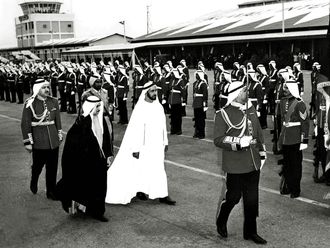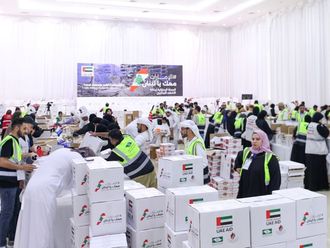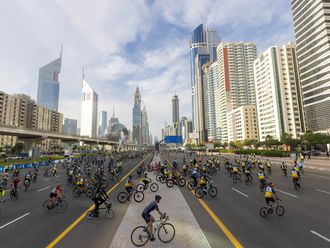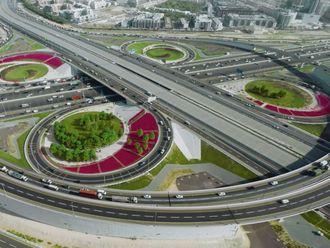The continuing popularity of the Dishdasha and Bisht, the traditional dress for UAE men, is a tribute to its suitability for the country's desert climate
The traditional costume is a focal part of any society's culture - but for UAE nationals it also highlights the pride they take in their Arab identity.
The fact that the country's traditional dress is used to this day is a tribute to its comfort and suitability for the difficult desert climate, now considerably alleviated through air conditioning.
Men in the UAE are proud of their way of life, and their dress displays a high level of sophistication and elaboration which reveals the wearer's social standing.
On formal occasions, especially ceremonial one, a Bisht - also called the "wing of the Arab" - a sleeveless flowing black, white, or beige cloak trimmed with gold whose material depends on the social status of the wearer, is sometimes worn on top of the Dishdasha. The thicker kinds are made from wool or cotton whereas the lighter ones are made from a kind of see-through linen.
"The Bisht has different names in relation to the social rank of its wearer," said Alawi Abd Muslim Al Khalidi, an Iraqi tailor plying his trade since 1947. "I learned that when I was a child in Iraq as this was an important job in our country. Now I have a shop in Ras Al Khaimah and my customers include high-ranking men.
"Most of the Sheikhs are my customers, and they have very high standards when choosing their Bisht."
"There is the first grade, which is embroidered with silk, silver and gold. We usually bring the thread from Syria, France or Germany.
"The best Bisht is hand-made with soft wool. We comb the wool then wash it, then we comb it again then we send it to the weaver. Then it is ready for tailoring."
| Al Khalidi shows another kind of Bisht known as Al Mandili |
The price of the Bisht may exceed Dh15,000 depending on the amount of gold and silver used in it, which might be of 22, 18, or 12 carat.
The other grades may cost Dh1,500, Dh1,000, Dh500 or even Dh200. In these the embroidery is of copper whose colour might run.
But the Malaki or Mandili embroidery lasts for more than five years.
The thread used for embroidery is called Al Ziri, which is usually imported from abroad.
He explained that the hand weaving of the Bisht is called Al Najafi, and it can take more than 15 days for one piece. In a factory they can make 100 pieces a day.
"We have customers coming from Kuwait, Saudi Arabia, and Bahrain," he said.
He added that each Bisht embroidery passes through four stages. First is Al Mekser, the embroidery at the top of the Bisht, then Al Sumout, followed by Al Arj, and then Al Hailah, the last step. Four people are needed for the four stages, and it takes three days to finish one piece.
The Bisht has been a traditional Arab dress for thousands of years. Men in all the Arab countries wear it. Here it is the dress of only high-class people. In the past, every body could wear it, but now it is for important occasions only.
Men in the UAE traditionally wear an ankle-length, cool, loose-fitting, and supremely comfortable garment called the Dishdasha or Kandura. The traditional UAE Dishdasha is made originally from cotton and tailored in various shades of white, off-white, and sometimes in dark colours.
Instead of a collar, a long twisted piece of the same material dangles at an arm's length from the neck with a long tassel at the end of it.
On their heads, the UAE men wear what is known as a Gahfiyya or a small flat turban which holds the Ghutra in place. The Ghutra is a square piece of cloth shaped as a triangle and worn on the head.
To secure the two pieces in place, the Agal, which is a black thick circular band made from twisted wool, is used around the crown and at the back two or three long tassles of the same material hang down. The Agal comes in various forms and at times without the extra tassles in the back. Sometimes it comes in white (usually worn by religious scholars).
Originally, the UAE men did not wear the Agal and their headpieces consisted of the turban and the Ghutra which was wrapped loosely around the head.
Younger men today may be seen wearing the Ghutra wrapped in a special way around their head. When it is worn that way, it is known as a Hamdaniyya. Although the Ghutra is usually white, some men use a red- and white-patterned one.
Clothes are of many kinds all over the world. Each society has its own way of developing clothing. So too the UAE, where the Bisht adds that extra touch of class.











